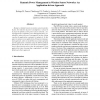174 search results - page 17 / 35 » A Recursive Battery Model for Nodes Lifetime Estimation in W... |
WONS
2005
IEEE
14 years 2 months ago
2005
IEEE
Energy is a limited resource in wireless sensor networks. In fact, the reduction of power consumption is crucial to increase the lifetime of low power sensor networks. Several app...
COLCOM
2009
IEEE
14 years 1 months ago
2009
IEEE
—Sensing coverage and network connectivity are two fundamental issues in wireless sensor networks (WSNs). Due to resource constraints of sensor nodes, it may not be possible, or ...
NETWORK
2006
13 years 9 months ago
2006
Wireless Sensor Networks (WSNs) are expected to be deployed for long periods of time, and the nodes are likely to need software updates during their lifetime, both for bug fixes a...
JSAC
2010
13 years 7 months ago
2010
Abstract—Wireless Sensor Networks are well suited for tracking targets carrying RFID tags in indoor environments. Tracking based on the received signal strength indication (RSSI)...
WINET
2011
13 years 3 months ago
2011
Sleep scheduling, which is putting some sensor nodes into sleep mode without harming network functionality, is a common method to reduce energy consumption in dense wireless sensor...

